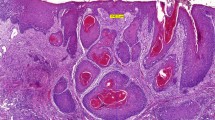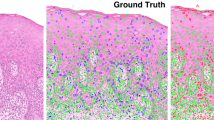Abstract
Tumour cells at the invasive front of carcinomas have been found to differ substantially from the rest of tumour cells in a variety of human cancers. The present multivariate survival analysis of 94 oral squamous cell carcinomas (OSCCs) revealed that both the argyrophilic nucleolar organizer regions-associated protein (AgNOR) content of invading tumour cells and a multiparametric histopathological tumour front grade were significantly and independently associated with tumour-related death, irrespective of conventional Broders' grade and clinical stage of the tumours. High tumour front scores and AgNOR content at the invasive OSCC front thus seem to reflect increased malignant potential. Proliferative activity, assessed by standardized AgNOR analysis, most probably represents one of the biological features underlying the usefulness of evaluating the invasive tumour front.
Similar content being viewed by others
Author information
Authors and Affiliations
Rights and permissions
About this article
Cite this article
Piffkò, J., Bànkfalvi, A., Öfner, D. et al. Prognostic value of histobiological factors (malignancy grading and AgNOR content) assessed at the invasive tumour front of oral squamous cell carcinomas. Br J Cancer 75, 1543–1546 (1997). https://doi.org/10.1038/bjc.1997.263
Issue Date:
DOI: https://doi.org/10.1038/bjc.1997.263
- Springer Nature Limited
This article is cited by
-
Assessment of proliferating cell nuclear antigen (PCNA) expression at the invading front of oral squamous cell carcinoma
BMC Oral Health (2019)
-
Expression of E-cadherin and β-catenin in basaloid and conventional squamous cell carcinoma of the oral cavity: are potential prognostic markers?
BMC Cancer (2014)
-
Cancer stem cell characteristics, ALDH1 expression in the invasive front of nasopharyngeal carcinoma
Virchows Archiv (2014)
-
Reproducibility of histopathologic tumor grading in penile cancer—results of a European project
Virchows Archiv (2014)
-
Collagenase-2 (matrix metalloproteinase-8) plays a protective role in tongue cancer
British Journal of Cancer (2008)




